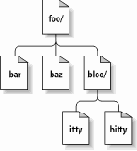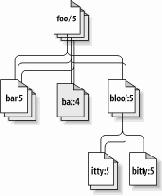Repository Layer
When referring to Subversion's Repository Layer, we're generally talking about two libraries—the repository library, and the filesystem library. These libraries provide the storage and reporting mechanisms for the various revisions of your version-controlled data. This layer is connected to the Client Layer via the Repository Access Layer, and is, from the perspective of the Subversion user, the stuff at the «other end of the line.»
The Subversion Filesystem is accessed via the libsvn_fs API, and is not a kernel-level filesystem that one would install in an operating system (like the Linux ext2 or NTFS), but a virtual filesystem. Rather than storing «files» and «directories» as real files and directories (as in, the kind you can navigate through using your favorite shell program), it uses one of two available abstract storage backends—either a Berkeley DB database environment, or a flat-file representation. (To learn more about the two repository back-ends, see «Repository Data Stores».) However, there has been considerable interest by the development community in giving future releases of Subversion the ability to use other back-end database systems, perhaps through a mechanism such as Open Database Connectivity (ODBC).
The filesystem API exported by libsvn_fs contains the kinds of functionality you would expect from any other filesystem API: you can create and remove files and directories, copy and move them around, modify file contents, and so on. It also has features that are not quite as common, such as the ability to add, modify, and remove metadata («properties») on each file or directory. Furthermore, the Subversion Filesystem is a versioning filesystem, which means that as you make changes to your directory tree, Subversion remembers what your tree looked like before those changes. And before the previous changes. And the previous ones. And so on, all the way back through versioning time to (and just beyond) the moment you first started adding things to the filesystem.
All the modifications you make to your tree are done within the context of a Subversion transaction. The following is a simplified general routine for modifying your filesystem:
Begin a Subversion transaction.
Make your changes (adds, deletes, property modifications, etc.).
Commit your transaction.
Once you have committed your transaction, your filesystem modifications are permanently stored as historical artifacts. Each of these cycles generates a single new revision of your tree, and each revision is forever accessible as an immutable snapshot of «the way things were.»
The Transaction Distraction
The notion of a Subversion transaction, especially given its close proximity to the database code in libsvn_fs, can become easily confused with the transaction support provided by the underlying database itself. Both types of transaction exist to provide atomicity and isolation. In other words, transactions give you the ability to perform a set of actions in an «all or nothing» fashion—either all the actions in the set complete with success, or they all get treated as if none of them ever happened—and in a way that does not interfere with other processes acting on the data.
Database transactions generally encompass small operations related specifically to the modification of data in the database itself (such as changing the contents of a table row). Subversion transactions are larger in scope, encompassing higher-level operations like making modifications to a set of files and directories which are intended to be stored as the next revision of the filesystem tree. If that isn't confusing enough, consider this: Subversion uses a database transaction during the creation of a Subversion transaction (so that if the creation of Subversion transaction fails, the database will look as if we had never attempted that creation in the first place)!
Fortunately for users of the filesystem API, the transaction support provided by the database system itself is hidden almost entirely from view (as should be expected from a properly modularized library scheme). It is only when you start digging into the implementation of the filesystem itself that such things become visible (or interesting).
Most of the functionality provided by the filesystem interface comes as an action that occurs on a filesystem path. That is, from outside of the filesystem, the primary mechanism for describing and accessing the individual revisions of files and directories comes through the use of path strings like /foo/bar, just as if you were addressing files and directories through your favorite shell program. You add new files and directories by passing their paths-to-be to the right API functions. You query for information about them by the same mechanism.
Unlike most filesystems, though, a path alone is not enough information to identify a file or directory in Subversion. Think of a directory tree as a two-dimensional system, where a node's siblings represent a sort of left-and-right motion, and descending into subdirectories a downward motion. Ðèñóíîê 8.1, «Files and directories in two dimensions» shows a typical representation of a tree as exactly that.
Ðèñóíîê 8.1. Files and directories in two dimensions

Of course, the Subversion filesystem has a nifty third dimension that most filesystems do not have—Time! [47] In the filesystem interface, nearly every function that has a path argument also expects a root argument. This svn_fs_root_t argument describes either a revision or a Subversion transaction (which is usually just a revision-to-be), and provides that third-dimensional context needed to understand the difference between /foo/bar in revision 32, and the same path as it exists in revision 98. Ðèñóíîê 8.2, «Versioning time—the third dimension!» shows revision history as an added dimension to the Subversion filesystem universe.
Ðèñóíîê 8.2. Versioning time—the third dimension!

As we mentioned earlier, the libsvn_fs API looks and feels like any other filesystem, except that it has this wonderful versioning capability. It was designed to be usable by any program interested in a versioning filesystem. Not coincidentally, Subversion itself is interested in that functionality. But while the filesystem API should be sufficient for basic file and directory versioning support, Subversion wants more—and that is where libsvn_repos comes in.
The Subversion repository library (libsvn_repos) is basically a wrapper library around the filesystem functionality. This library is responsible for creating the repository layout, making sure that the underlying filesystem is initialized, and so on. Libsvn_repos also implements a set of hooks—scripts that are executed by the repository code when certain actions take place. These scripts are useful for notification, authorization, or whatever purposes the repository administrator desires. This type of functionality, and other utilities provided by the repository library, are not strictly related to implementing a versioning filesystem, which is why it was placed into its own library.
Developers who wish to use the libsvn_repos API will find that it is not a complete wrapper around the filesystem interface. That is, only certain major events in the general cycle of filesystem activity are wrapped by the repository interface. Some of these include the creation and commit of Subversion transactions, and the modification of revision properties. These particular events are wrapped by the repository layer because they have hooks associated with them. In the future, other events may be wrapped by the repository API. All of the remaining filesystem interaction will continue to occur directly via the libsvn_fs API, though.
For example, here is a code segment that illustrates the use of both the repository and filesystem interfaces to create a new revision of the filesystem in which a directory is added. Note that in this example (and all others throughout this book), the SVN_ERR() macro simply checks for a non-successful error return from the function it wraps, and returns that error if it exists.
Ïðèìåð 8.1. Using the Repository Layer
/* Create a new directory at the path NEW_DIRECTORY in the Subversion repository located at REPOS_PATH. Perform all memory allocation in POOL. This function will create a new revision for the addition of NEW_DIRECTORY. */ static svn_error_t * make_new_directory (const char *repos_path, const char *new_directory, apr_pool_t *pool) { svn_error_t *err; svn_repos_t *repos; svn_fs_t *fs; svn_revnum_t youngest_rev; svn_fs_txn_t *txn; svn_fs_root_t *txn_root; const char *conflict_str; /* Open the repository located at REPOS_PATH. */ SVN_ERR (svn_repos_open (&repos, repos_path, pool));/* Get a pointer to the filesystem object that is stored in REPOS. */ fs = svn_repos_fs (repos); /* Ask the filesystem to tell us the youngest revision that currently exists. */ SVN_ERR (svn_fs_youngest_rev (&youngest_rev, fs, pool)); /* Begin a new transaction that is based on YOUNGEST_REV. We are less likely to have our later commit rejected as conflicting if we always try to make our changes against a copy of the latest snapshot of the filesystem tree. */ SVN_ERR (svn_fs_begin_txn (&txn, fs, youngest_rev, pool)); /* Now that we have started a new Subversion transaction, get a root object that represents that transaction. */ SVN_ERR (svn_fs_txn_root (&txn_root, txn, pool)); /* Create our new directory under the transaction root, at the path NEW_DIRECTORY. */ SVN_ERR (svn_fs_make_dir (txn_root, new_directory, pool)); /* Commit the transaction, creating a new revision of the filesystem which includes our added directory path. */ err = svn_repos_fs_commit_txn (&conflict_str, repos, &youngest_rev, txn, pool); if (! err) { /* No error? Excellent! Print a brief report of our success. */ printf ("Directory '%s' was successfully added as new revision " "'%ld'.\n", new_directory, youngest_rev); } else if (err->apr_err == SVN_ERR_FS_CONFLICT) { /* Uh-oh. Our commit failed as the result of a conflict (someone else seems to have made changes to the same area of the filesystem that we tried to modify). Print an error message. */ printf ("A conflict occurred at path '%s' while attempting " "to add directory '%s' to the repository at '%s'.\n", conflict_str, new_directory, repos_path); } else { /* Some other error has occurred. Print an error message. */ printf ("An error occurred while attempting to add directory '%s' " "to the repository at '%s'.\n", new_directory, repos_path); } /* Return the result of the attempted commit to our caller. */ return err; }
In the previous code segment, calls were made to both the repository and filesystem interfaces. We could just as easily have committed the transaction using svn_fs_commit_txn(). But the filesystem API knows nothing about the repository library's hook mechanism. If you want your Subversion repository to automatically perform some set of non-Subversion tasks every time you commit a transaction (like, for example, sending an email that describes all the changes made in that transaction to your developer mailing list), you need to use the libsvn_repos-wrapped version of that function—svn_repos_fs_commit_txn(). This function will actually first run the pre-commit hook script if one exists, then commit the transaction, and finally will run a post-commit hook script. The hooks provide a special kind of reporting mechanism that does not really belong in the core filesystem library itself. (For more information regarding Subversion's repository hooks, see «Hook Scripts».)
The hook mechanism requirement is but one of the reasons for the abstraction of a separate repository library from the rest of the filesystem code. The libsvn_repos API provides several other important utilities to Subversion. These include the abilities to:
create, open, destroy, and perform recovery steps on a Subversion repository and the filesystem included in that repository.
describe the differences between two filesystem trees.
query for the commit log messages associated with all (or some) of the revisions in which a set of files was modified in the filesystem.
generate a human-readable «dump» of the filesystem, a complete representation of the revisions in the filesystem.
parse that dump format, loading the dumped revisions into a different Subversion repository.
As Subversion continues to evolve, the repository library will grow with the filesystem library to offer increased functionality and configurable option support.
